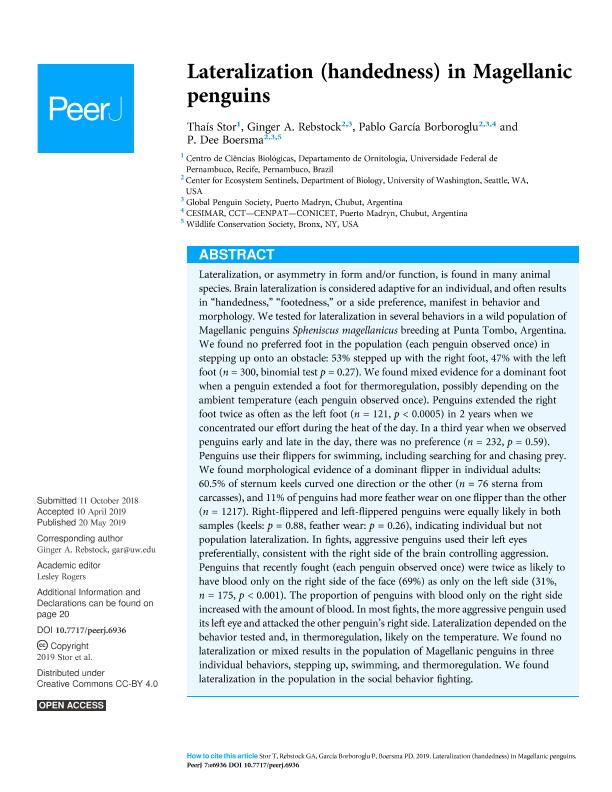Artículo
Lateralization (handedness) in Magellanic penguins
Fecha de publicación:
05/2019
Editorial:
PeerJ
Revista:
PeerJ
ISSN:
2167-8359
Idioma:
Inglés
Tipo de recurso:
Artículo publicado
Clasificación temática:
Resumen
Lateralization, or asymmetry in form and/or function, is found in many animal species. Brain lateralization is considered adaptive for an individual, and often results in "handedness," "footedness," or a side preference, manifest in behavior and morphology. We tested for lateralization in several behaviors in a wild population of Magellanic penguins Spheniscus magellanicus breeding at Punta Tombo, Argentina. We found no preferred foot in the population (each penguin observed once) in stepping up onto an obstacle: 53% stepped up with the right foot, 47% with the left foot (n = 300, binomial test p = 0.27). We found mixed evidence for a dominant foot when a penguin extended a foot for thermoregulation, possibly depending on the ambient temperature (each penguin observed once). Penguins extended the right foot twice as often as the left foot (n = 121, p 0.0005) in 2 years when we concentrated our effort during the heat of the day. In a third year when we observed penguins early and late in the day, there was no preference (n = 232, p = 0.59). Penguins use their flippers for swimming, including searching for and chasing prey. We found morphological evidence of a dominant flipper in individual adults: 60.5% of sternum keels curved one direction or the other (n = 76 sterna from carcasses), and 11% of penguins had more feather wear on one flipper than the other (n = 1217). Right-flippered and left-flippered penguins were equally likely in both samples (keels: p = 0.88, feather wear: p = 0.26), indicating individual but not population lateralization. In fights, aggressive penguins used their left eyes preferentially, consistent with the right side of the brain controlling aggression. Penguins that recently fought (each penguin observed once) were twice as likely to have blood only on the right side of the face (69%) as only on the left side (31%, n = 175, p 0.001). The proportion of penguins with blood only on the right side increased with the amount of blood. In most fights, the more aggressive penguin used its left eye and attacked the other penguin's right side. Lateralization depended on the behavior tested and, in thermoregulation, likely on the temperature. We found no lateralization or mixed results in the population of Magellanic penguins in three individual behaviors, stepping up, swimming, and thermoregulation. We found lateralization in the population in the social behavior fighting.
Archivos asociados
Licencia
Identificadores
URL:
https://peerj.com/
Colecciones
Articulos(CESIMAR)
Articulos de CENTRO PARA EL ESTUDIO DE SISTEMAS MARINOS
Articulos de CENTRO PARA EL ESTUDIO DE SISTEMAS MARINOS
Citación
Stor, Thaís; Rebstock, Ginger A.; Garcia Borboroglu, Jorge Pablo; Boersma, P. Dee; Lateralization (handedness) in Magellanic penguins; PeerJ; PeerJ; 2019; 5; 5-2019; 1-25
Compartir
Altmétricas




